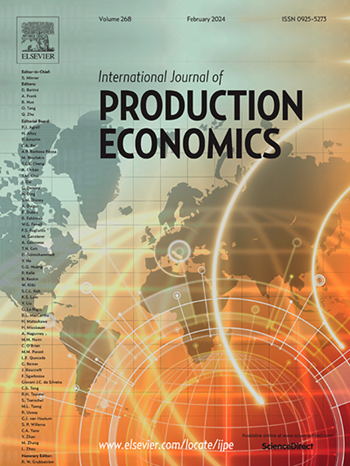The cyclic inventory routing problem with environmental considerations: Model, solution procedure, and insights
IF 10
1区 工程技术
Q1 ENGINEERING, INDUSTRIAL
引用次数: 0
Abstract
This paper introduces and studies the Cyclic Inventory Routing Problem with Environmental (CIRP-E) considerations which plans the distribution from a single depot to multiple customers with the objective of minimizing the average cost of transportation, inventory, fuel, and carbon emissions subject to constraints related to demand satisfaction, vehicle and storage capacities, and driving hours limitations. CIRP-E integrates strategic fleet sizing, tactical route design, lot sizing and speed selection, together with operational vehicle scheduling. We derive analytical results for vehicle speed and cycle times, and study how they affect fleet sizing and vehicle scheduling. These results and insights are then exploited to develop heuristics which are embedded in a powerful two-phase metaheuristic solution approach for CIRP-E. The first phase designs vehicle routes and decides on vehicle speed and cycle times to minimize the total cost rate. The second phase takes the designed routes as input and decides on fleet sizing and scheduling of deliveries, while adjusting vehicle speeds and cycle times. Computational experiments show that the proposed solution approach adequately trades-off the various cost components and outperforms different adaptations of a state-of-the-art solution method for the classical cyclic inventory routing problem.
考虑环境因素的循环库存路线问题:模型、解决方案过程和见解
本文介绍并研究了考虑环境因素的循环库存路径问题(CIRP-E),该问题规划了从一个仓库到多个客户的分配,目标是在满足需求、车辆和存储容量以及驾驶时间限制的约束下,最小化运输、库存、燃料和碳排放的平均成本。CIRP-E集成了战略车队规模、战术路线设计、批量规模和速度选择,以及作战车辆调度。我们得到了车辆速度和循环时间的分析结果,并研究了它们如何影响车队规模和车辆调度。然后利用这些结果和见解来开发启发式方法,这些启发式方法嵌入在CIRP-E的强大的两阶段元启发式解决方法中。第一阶段设计车辆路线,确定车辆速度和循环时间,以使总成本率最小。第二阶段将设计的路线作为输入,决定车队规模和交付计划,同时调整车辆速度和周期时间。计算实验表明,所提出的解决方法充分权衡了各种成本组成部分,并且优于经典循环库存路径问题的最新解决方法的不同适应性。
本文章由计算机程序翻译,如有差异,请以英文原文为准。
求助全文
约1分钟内获得全文
求助全文
来源期刊
CiteScore
21.40
自引率
7.50%
发文量
266
审稿时长
52 days
期刊介绍:
The International Journal of Production Economics focuses on the interface between engineering and management. It covers all aspects of manufacturing and process industries, as well as production in general. The journal is interdisciplinary, considering activities throughout the product life cycle and material flow cycle. It aims to disseminate knowledge for improving industrial practice and strengthening the theoretical base for decision making. The journal serves as a forum for exchanging ideas and presenting new developments in theory and application, combining academic standards with practical value for industrial applications.

 求助内容:
求助内容: 应助结果提醒方式:
应助结果提醒方式:


